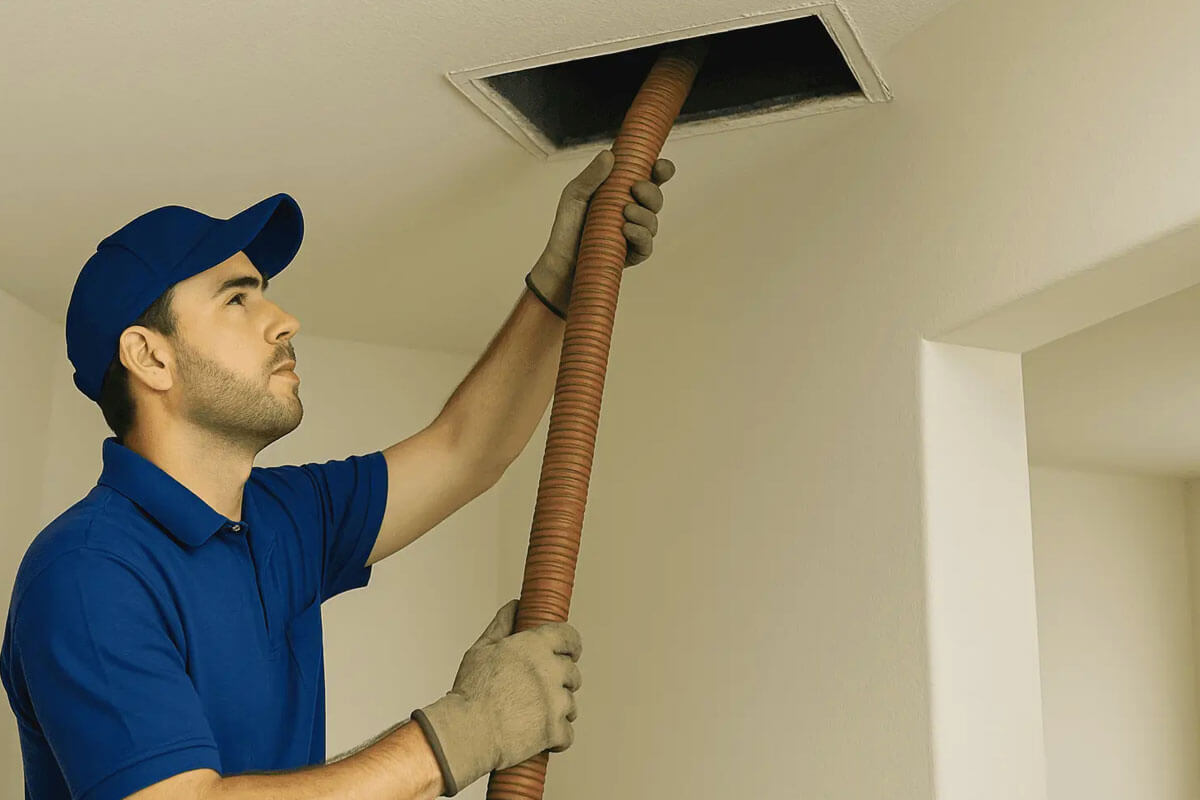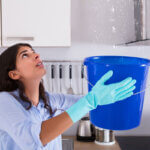Cleaning dirty air ducts involves removing dust, debris, and contaminants from your home’s ventilation maintenance system to improve indoor air quality and system efficiency. While you can handle basic maintenance yourself, professional cleaning is often necessary for deep contamination. How to clean dirty air ducts safely requires the right tools, techniques, and knowing when to call experts.
Signs Your Air Ducts Need Cleaning
You should clean your air ducts when you notice visible contamination, poor airflow, or health-related issues that signal air duct contamination.
Watch for these clear warning signs that indicate your ducts need attention. Mold in ducts appears as dark spots around vents or creates musty odors when your system runs. The EPA warns that moisture presence increases potential for microbiological growth, and spores from such growth may be released into the home’s living space. Dust buildup becomes obvious when you see particles blowing from vents or coating register covers. Poor airflow from vents means your system works harder to circulate air.
Unexplained allergies or respiratory issues that worsen indoors often point to contaminated ductwork. Pest infestation signs include droppings, nesting materials, or strange sounds from ducts. The average family generates nearly forty pounds of dust annually, which accumulates in your HVAC system over time. Recent home renovations create extra debris that settles in your system. Energy bills that spike without explanation might indicate blocked airflow forcing your system to work overtime.
How to Clean Dirty Air Ducts: DIY Steps
Basic DIY duct cleaning can address surface contamination but won’t replace professional ductwork servicing.
Start by turning off your HVAC maintenance system completely at the thermostat and main power switch. The EPA emphasizes that moisture should not be present in ducts, and steam cleaning or other moisture-involving methods should not be used on any kind of ductwork. Remove vent covers using a screwdriver and soak them in warm, soapy water. Use a vacuum with a long hose attachment to remove visible debris from the first few feet of ductwork. This register cleaning process helps with surface buildup.
Scrub vent covers with a brush to remove stuck-on grime, then rinse and dry completely. Clean accessible duct surfaces with a damp cloth, avoiding harsh chemicals that could damage materials. Replace your air filter replacement with a high-quality filter before reassembling everything. Vacuum around the furnace area and wipe down the blower compartment if accessible. This basic preventive maintenance helps but only reaches surface areas that you can see and access easily.
Essential Tools for DIY Cleaning
Gather these basic tools before starting your vent cover cleaning project.
You’ll need a powerful vacuum cleaner with attachments, screwdrivers for removing covers, drop cloths to protect floors, and cleaning cloths or rags. A flashlight or headlamp helps you see inside ducts clearly. Mild dish soap works best for cleaning covers without damaging finishes. A stiff brush removes stubborn debris from covers and accessible duct surfaces. Professional-grade equipment includes specialized brushes, HEPA filters, and negative pressure systems that household equipment cannot match.
Safety Precautions
Protect yourself during the health-conscious cleaning process to avoid health risks.
Wear a dust mask or respirator to avoid breathing contaminated particles. Safety glasses prevent debris from getting in your eyes. Gloves protect your hands from sharp metal edges and contaminants. If you have insulated air ducts and the insulation gets wet or moldy, it cannot be effectively cleaned and should be removed and replaced. Never use chemical cleaners inside ducts since they can release harmful fumes through your home. Avoid damaging flexible ductwork by being gentle with tools and brushes.
When and Why to Hire a Professional
Professional duct cleaner services become necessary for deep contamination, complex systems, or when DIY efforts prove insufficient.
The EPA only recommends cleaning your ducts if there’s visible contamination, such as mold growth, pest infestations, or major renovations that left behind dust and debris. Call professionals immediately if you discover mold in ducts, signs of rodent infestation, or water damage. These situations require specialized equipment and expertise to handle safely. Professional cleaning costs typically range from $450 to $1,000 according to the National Air Duct Cleaners Association (NADCA).
Complex duct systems with multiple levels or hard-to-reach areas need professional-grade equipment for thorough HVAC system cleaning. The most effective method involves source removal using continuous negative pressure with specialized, powerful vacuums. Professionals use high-powered vacuums, rotating brushes, and negative pressure systems that household equipment can’t match. The NADCA Energy Study shows that even small amounts of debris can reduce HVAC efficiency by up to 40%.
Look for NADCA-certified companies that follow industry standards. NADCA certification requires technicians to pass testing and adhere to published cleaning standards. Avoid companies offering extremely low prices, as these often involve bait-and-switch tactics with hidden fees.
Professional Duct Cleaning Costs and What to Expect
Understanding current pricing helps you budget and avoid scams in the HVAC cleaning industry.
Most duct cleaning professionals charge between $90 and $125 per hour, with jobs typically requiring three to eight hours depending on home size and system complexity. Companies may charge $0.15 to $0.40 per square foot or $25 to $50 per supply vent. The complexity of your whole-house air cleaning needs affects final costs significantly.
Beware of “whole house specials” for very low prices, as these often involve hidden charges for cleaning air handlers, coils, registers, and other essential components. Legitimate companies provide upfront, itemized estimates covering all necessary supply duct cleaning and return duct cleaning work. Experts recommend cleaning ducts every 3-5 years for most homes, with more frequent service needed for homes with pets, smokers, or allergy sufferers.
Additional costs apply for special situations. Mold remediation costs typically range from $500 to $2,000 depending on severity. Dryer vent cleaning costs $150 to $250 and should be done annually for safety. Water damage or pest remediation requires separate pricing based on the extent of contamination.
What Professional Cleaning Includes
Comprehensive air duct cleaning involves more than just vacuuming visible surfaces through HVAC system maintenance.
NADCA standards require source removal methods that physically dislodge and remove contaminants rather than just moving them around. Professionals clean supply ducts, return ducts, registers, grilles, diffusers, coils, drain pans, and the air handling unit. They use specialized brushes, high-powered vacuums, and compressed air tools designed specifically for ductwork. The EPA and NADCA don’t recommend chemical treatments inside ducts, as antimicrobial sprays can do more harm than good.
Quality companies perform pre-cleaning inspections and post-cleaning verification. Visual inspection and photo documentation help verify thorough cleaning. Some companies use cameras to show you before-and-after conditions inside your ducts, demonstrating the difference between cleaning (simple debris removal) and comprehensive remediation (complete system restoration).
Routine Maintenance to Reduce Need for Cleaning
Preventive HVAC maintenance extends time between professional cleanings and keeps your system running efficiently while preventing duct neglect.
Replace filters regularly based on manufacturer recommendations, typically every 1-3 months depending on filter type and home conditions. High-efficiency filters capture more particles but may restrict airflow if not changed frequently enough. Vacuum around vents and registers monthly to prevent surface dust from entering the system. Keep outdoor units clear of debris, leaves, and vegetation that can block airflow.
Seal air leaks around ductwork in accessible areas like basements and crawl spaces. These leaks allow unfiltered air and contaminants to enter your system. Schedule annual HVAC tune-ups to catch problems early and maintain peak efficiency. Professional technicians can spot issues during routine maintenance that might require cleaning attention.
Control moisture levels in your home to prevent mold growth. Experts agree that moisture should not be present in ducts, and controlling moisture is the most effective way to prevent biological growth in all types of air ducts. Use exhaust fans in bathrooms and kitchens, fix plumbing leaks promptly, and maintain proper humidity levels between 30-50%. Modern technological advances include AI-powered diagnostics and electrostatic dust removal systems that enhance cleaning effectiveness.
Smart Prevention Strategies
Simple habits make a big difference in keeping your ducts cleaner longer through airflow improvement techniques.
Change filters before they become completely clogged to maintain good airflow and dust removal efficiency. Vacuum regularly and use doormats to reduce the amount of dirt entering your home. Keep pet dander under control with regular grooming and cleaning. Address any water leaks or moisture problems immediately to prevent mold growth, following principles of indoor air quality improvement.
Consider upgrading to higher-quality filters if you have allergies or pets, but make sure they’re compatible with your system. Some high-efficiency filters can restrict airflow in older systems not designed for them. Monitor your energy bills for unexplained increases that might indicate system problems requiring attention. This approach represents the evolution of air conditioning maintenance (from the Latin “conditio” meaning arrangement or proper state).
Bottom Line
How to clean dirty air ducts successfully combines basic DIY maintenance with professional deep cleaning when needed. While you can handle surface cleaning and routine maintenance yourself, complex contamination requires professional expertise and equipment. Clean ducts can improve system efficiency by up to 40%, making professional cleaning a worthwhile investment every 3-5 years. Focus on prevention through regular filter changes and moisture control to extend time between professional cleanings and maintain healthy indoor air quality year-round.





